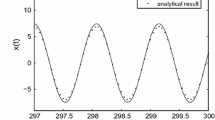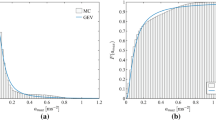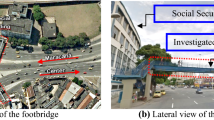Abstract
Purpose
In the assessment of footbridge lateral vibrations, the modeling of human-structure interaction requires representation of the dynamics of the human body and the forces induced by people walking, and additionally, consideration of the effects of the crowd. This way, this paper presents a single degree of freedom biodynamic model to represent the action of a walking pedestrian in the lateral direction.
Methods
The biodynamic parameters of mass, stiffness and damping, as well as the dynamic load factor were determined from the measured acceleration of people's center of mass. Before the identification of the parameters in the lateral direction, an initial experimental campaign was carried out to identify and characterize the corporal movements of the pedestrians, define a procedure to process the acquired signals and observe the effect of the crowd on such corporal movements, specifically on acceleration and rotation of the pedestrian's pelvis. A second campaign was carried with people walking alone and later in crowd. In the first stage, each participant walked alone with their normal (free) pacing frequency and metronome-controlled pacing frequencies. Subsequently, each individual walked in group with two crowd density conditions.
Results
Comparison between biodynamic parameters of people walking individually and in a crowd allowed the identification of the influence caused by the crowd. Also, regression expressions were obtained by relating the biodynamic parameters to the walking lateral frequency and body mass of the pedestrian, for both free walking and walking in crowd conditions.
Conclusion
The values of the parameters obtained and the regressions expressions of the biodynamic model in the lateral direction can be used in the study of the human-structure interaction in footbridges.











Similar content being viewed by others
Data Availability
All data are fully available on request.
References
Fujino Y, Pacheco B, Nakamura SI, Warnitchai P (1993) Synchronization of human walking observed during lateral vibration of a congested pedestrian bridge. Earthq Eng Struct Dyn 22(9):741–758. https://doi.org/10.1002/eqe.4290220902
Dallard P, Flint A, Le Bourva S, Low A, Smith RMR, Willford M (2001) The London Millennium Footbridge. Struct Eng 79(22):17–35
Dallard BP, Fitzpatrick T, Flint A, Low A, Smith RR, Willford M, Roche M (2001) London Millennium Bridge: pedestrian-induced lateral vibration. J Bridg Eng 6(6):412–417. https://doi.org/10.1061/(ASCE)1084-0702(2001)6:6(412)
Strogatz SH, Abrams DM, Mcrobie A, Eckhardt B, Ott E (2005) Crowd synchrony on the Millennium Bridge. Nature 438(7064):43–44. https://doi.org/10.1038/438043a
Macdonald JHG (2009) Lateral excitation of bridges by balancing pedestrians. Proc R Soc A 465(2104):1055–1073. https://doi.org/10.1098/rspa.2008.0367
Ingólfsson ET, Georgakis CT, Jönsson J (2012) Pedestrian-induced lateral vibrations of footbridges: a literature review. Eng Struct 45:21–52. https://doi.org/10.1016/j.engstruct.2012.05.038
Casciati S (2016) Human induced vibration vs cable-stay footbridge deterioration. Smart Struct Syst 18(1):17–29. https://doi.org/10.12989/sss.2016.18.1.017
Bocian M, Brownjohn JMW, Racic V, Hester D, Quattrone A, Gilbert L, Beasley R (2018) Time-dependent spectral analysis of interactions within groups of walking pedestrians and vertical structural motion using wavelets. Mech Syst Signal Process 105:502–523. https://doi.org/10.1016/j.ymssp.2017.12.020
Ingólfsson ET, Georgakis CT, Ricciardelli F, Jönsson J (2011) Experimental identification of pedestrian-induced lateral forces on footbridges. J Sound Vib 330(6):1265–1284. https://doi.org/10.1016/j.jsv.2010.09.034
Da Silva FT, Pimentel RL (2011) Biodynamic walking model for vibration serviceability of footbridges in vertical direction. Proceeding of the 8th International Conference on Structural Dynamics (Eurodyn 2011). Belgium, Leuven, pp 1090–1096
Toso MA, Gomes HM, Da Silva FT, Pimentel RL (2016) Experimentally fitted biodynamic models for pedestrian-structure interaction in walking situations. Mech Syst Signal Process 72–73:590–606. https://doi.org/10.1016/j.ymssp.2015.10.029
Dang HV, Živanović S (2015) Experimental characterisation of walking locomotion on rigid level surfaces using motion capture system. Eng Struct 91:141–154. https://doi.org/10.1016/j.engstruct.2015.03.003
Živanović S (2015) Modelling human actions on lightweight structures: experimental and numerical developments. MATEC Web of Conferences 24 (2015) 01005. EDP Sciences. https://doi.org/10.1051/matecconf/20152401005
Wang J, Chen J (2017) A comparative study on different walking load models. Struct Eng Mech. https://doi.org/10.12989/sem.2017.63.6.847
Ingólfsson E (2011). Pedestrian-induced lateral vibrations of footbridges. Experimental studies and probabilistic modelling. PhD thesis, Technical University of Denmark.
Hof AL, van Bockel RM, Schoppen T, Postema K (2007) Control of lateral balance in walking. Experimental findings in normal subjects and above-knee amputees. Gait Posture 25(2):250–258. https://doi.org/10.1016/j.gaitpost.2006.04.013
Bocian M, MacDonald JHG, Burn JF (2012) Biomechanically inspired modelling of pedestrian-induced forces on laterally oscillating structures. J Sound Vib 331(16):3914–3929. https://doi.org/10.1016/j.jsv.2012.03.023
Carroll SP, Owen JS, Hussein MFM (2013) A coupled biomechanical/discrete element crowd model of crowd–bridge dynamic interaction and application to the Clifton Suspension. Bridge Eng Struct 49:58–75. https://doi.org/10.1016/j.engstruct.2012.10.020
McRobie FA (2013) Long-term solutions of Macdonald’s model for pedestrian-induced lateral forces. J Sound Vib 332(11):2846–2855. https://doi.org/10.1016/j.jsv.2012.12.027
Carroll SP, Owen JS, Hussein MFM (2014) Experimental identification of the lateral human-structure interaction mechanism and assessment of the inverted-pendulum biomechanical model. J Sound Vib 333(22):5865–5884. https://doi.org/10.1016/j.jsv.2014.06.022
Varela WD, Pfeil MS, da Costa NPA (2020) Experimental investigation on human walking loading parameters and biodynamic model. J Vib Eng Technol 8(6):883–892. https://doi.org/10.1007/s42417-020-00197-3 (Springer Singapore)
Mohammed AS, Pavic A (2017) Evaluation of mass-spring-damper models for dynamic interaction between walking humans and civil structures. Dynamics of civil structures, vol 2. Springer, Cham, pp 169–177
Jiménez-Alonso JF, Sáez A (2014) A direct pedestrian-structure interaction model to characterize the human induced vibrations on slender footbridges. Inf la Constr 66(1):1–9. https://doi.org/10.3989/ic.13.110
Lou J, Zhang M, Chen J (2015) Identification of stiffness, damping and biological force of SMD model for human walking. Dynamics of civil structures, vol 2. Springer, Cham, pp 331–337. https://doi.org/10.1007/978-3-319-15248-6_35
Shahabpoor E, Pavic A, Racic V (2015) Identification of mass-spring-damper model of walking humans. Structures 5:233–246. https://doi.org/10.1016/j.istruc.2015.12.001
Van Nimmen K, Maes K, Živanović S, Lombaert G, De Roeck G, Van Den Broeck P (2015) Identification and modelling of vertical human-structure interaction. Dynamics of civil structures, vol 2. Springer, Cham, pp 319–330. https://doi.org/10.1007/978-3-319-15248-6_34
Zhang M, Georgakis CT, Qu W, Chen J (2015) SMD model parameters of pedestrians for vertical human-structure interaction. Dynamics of Civil Structures, vol 2. Springer, Cham, pp 311–317. https://doi.org/10.1007/978-3-319-15248-6_33
Danbon F, Grillaud G (2005) Dynamic Behaviour of a Long-Span Steel Footbridge. Characterisation and Modelling of the Dynamic Loading Induced by a Moving Crowd on the Solférino Footbridge in Paris. In Footbridge 2005 (Second International Congress), Venezia, 06–08 December 2005 (p. 1).
Nakamura S-I (2004) Model for lateral excitation of footbridges by synchronous walking. J Struct Eng 130(1):32–37
Van Nimmen K, Van Hauwermeiren, J, Van den Broeck P (2020) Identification of Human-Structure Interaction Based on Full-Scale Observaions, Eurodyn 2020— XI International Conference on Structural Dynamics, Athens, 23–26 November 2020, Vol. 1, pp 1874–1882.
Rose J, Gamble JG (2006) Human Walking, 3rd edn. Lippnicott Williams & Wilkins, Philadelphia, USA
Saunders VT, Inman VT, Eberhart HD (1953) The major determinants in normal and pathological gait. Jt Bone Jt Surg 35(3):543–558
Ethier CR, Simmons CA (2007) introductory biomechanics: from cells to organisms. Cambridge University Press
Živanović S, Pavic A, Reynolds P (2005) Vibration serviceability of footbridges under human-induced excitation: a literature review. J Sound Vib 279(1):1–74. https://doi.org/10.1016/j.jsv.2004.01.019
Bachmann H, Ammann W (1987) Vibrations in structures: induced by man and machines Vol. 3:Iabse
Bachmann H, Pretlove AJ, Rainer, H (1995) Dynamic forces from rhythmical human body motions. Vibration problems in structures: Practical guidelines. Appendix G.
SÉTRA (2006) Assessment of vibrational behaviour of footbridges under pedestrian loading. Technical guide. SETRA, Paris, France
Ricciardelli F, Pizzimenti AD (2007) Lateral walking-induced forces on footbridges. J Bridg Eng 12:677–688. https://doi.org/10.1061/(ASCE)1084-0702(2007)12:6(677)
Archbold P, Mullarney B (2011) Lateral loads applied by pedestrians at normal walking velocities. Bridg Struct 7(2–3):75–86. https://doi.org/10.3233/BRS-2011-021
Clough RW, Penzien J (2003) Dynamics of structures. Computers & Structures Inc, USA
Da Silva FT, Brito HMBF, Pimentel RL (2013) Modeling of crowd load in vertical direction using biodynamic model for pedestrians crossing footbridges. Can J Civ Eng 40:1196–1204. https://doi.org/10.1139/cjce-2011-0587
Coermann RR (1962) The mechanical impedance of the human body in sitting and standing position at low frequencies. Hum Factors 4:227–253. https://doi.org/10.1177/001872086200400502
Foschi RO, Neumann G, Yao F, Folz B (1996) Floor vibration due to occupants and reliability-based design guidelines. Can J Civ Eng 23(2):572–572. https://doi.org/10.1139/l95-055
Al-Foqaha'a AA (1997) Design criterion for wood floor vibrations via finite element and reliability analyses. Ph.D. Dissertation, Washington State University, Pullman, USA.
Brownjohn JMW (1999) Energy dissipation in one-way slabs with human participation. In: Proceedings of the Asia-Pacific vibration conference. Nanyang Technological University, p. 155–60.
Falati S (1999) The Contribution of Non-Structural Components to the Overall Dynamic Behaviour of Concrete Floor Slabs Ph.D. Thesis, Oxford University, Oxford, UK.
Zheng X, Brownjohn JM (2001) Modeling and simulation of human-floor system under vertical vibration. Proc. SPIE 4327, Smart Structures and Materials 2001: Smart Structures and Integrated Systems. https://doi.org/10.1117/12.436586
Matsumoto Y, Griffin MJ (2003) Mathematical models for the apparent masses of standing subjects exposed to vertical whole-body vibration. J Sound Vib 260(3):431–451. https://doi.org/10.1016/S0022-460X(02)00941-0
Setareh M, Gan S (2016) Study of Human-Structure Dynamic Interactions. In: Allen M, Mayes R, Rixen D (eds) Dynamics of Coupled Structures, vol 4. Springer, Cham. https://doi.org/10.1007/978-3-319-29763-7_39
Archbold P (2004) Interactive Load Models for Pedestrian Footbridges. PhD thesis, University College Dublin, Ireland.
Ferris DP, Louie M, Farley CT (1998) Running in the real world: adjusting leg stiffness for different surfaces. Proc Biol Sci 265(1400):989–994. https://doi.org/10.1098/rspb.1998.0388
Arampatzis A, Brüggemann GP, Metzler V (1999) The Effect of Speed on Leg Stiffness and Joint Kinetics in Human Running. J Biomech 32:1349–1353. https://doi.org/10.1016/S0021-9290(99)00133-5
Farley CT, González O (1996) Leg stiffness and stride frequency in human running. J Biomech 29(2):181–186. https://doi.org/10.1016/0021-9290(95)00029-1
Cohen J (1988) Statistical Power Analysis for The Behavioral Sciences, 2nd Edition, L. Lawrence Earlbaum Associates, USA
Racic V, Brownjohn JMW (2012) Mathematical modelling of random narrow band lateral excitation of footbridges due to pedestrians walking. Comput Struct 90–91(1):116–130. https://doi.org/10.1016/j.compstruc.2011.10.002
Wang ZY, Zhang S, Wang HY, Song ZG (2016) Spectral characteristics of pedestrian loads under different crowd densities based on the modified bipedal walking model. Int Conf Mater Sci Civil Eng (MSCE 2016). https://doi.org/10.12783/dtmse/msce2016/10444
Peng Y, Chen J, Ding G (2015) Walking load model for single footfall trace in three dimensions based on gait experiment. Struct Eng Mech 54(5):937–953. https://doi.org/10.12989/sem.2015.54.5.937
Yang QS, Qin JW, Law SS (2015) A three-dimensional human walking model. J Sound Vib 357:437–456. https://doi.org/10.1016/j.jsv.2015.07.017
Fang Z, Lo SM, Lu JA (2003) On the relationship between crowd density and movement velocity. Fire Saf J 38(3):271–283. https://doi.org/10.1016/S0379-7112(02)00058-9
Bruno L, Venuti F (2008) The pedestrian speed–density relation: modelling and application. In: Proceedings of Footbridge, Porto, Portugal, July.
Venuti F, Bruno L (2009) Crowd-structure interaction in lively footbridges under synchronous lateral excitation: a literature review. Phys Life Rev 6(3):176–206. https://doi.org/10.1016/j.plrev.2009.07.001
Venuti F, Reggio A (2018) Mitigation of human-induced vertical vibrations of footbridges through crowd flow control. Struct Control Health Monit 25(12):e2266. https://doi.org/10.1002/stc.2266
Acknowledgements
The authors acknowledge the financial support of CAPES-Brazil and CNPQ-Brazil to carry out this research project.
Funding
The research leading to these results received funding from CAPES-Brazil and CNPQ-Brazil.
Author information
Authors and Affiliations
Corresponding author
Ethics declarations
Conflict of Interest
The authors declare that they have no competing interests.
Additional information
Publisher's Note
Springer Nature remains neutral with regard to jurisdictional claims in published maps and institutional affiliations.
Rights and permissions
About this article
Cite this article
Pena, A.N.P., de Brito, J.L.V., da Silva, F.F.G. et al. Pedestrian Biodynamic Model for Vibration Serviceability of Footbridges in Lateral Direction. J. Vib. Eng. Technol. 9, 1223–1237 (2021). https://doi.org/10.1007/s42417-021-00292-z
Received:
Revised:
Accepted:
Published:
Issue Date:
DOI: https://doi.org/10.1007/s42417-021-00292-z




